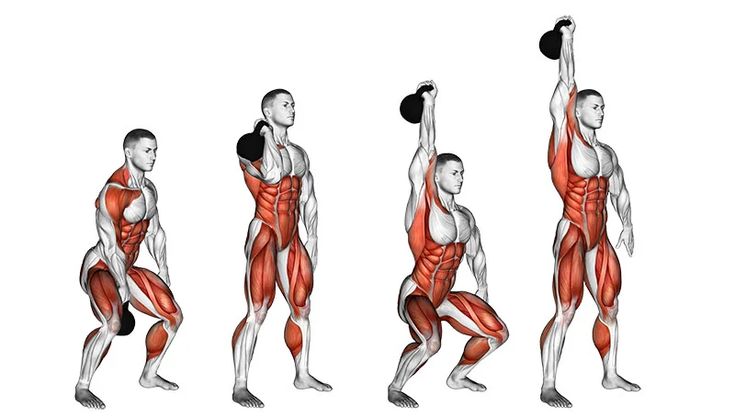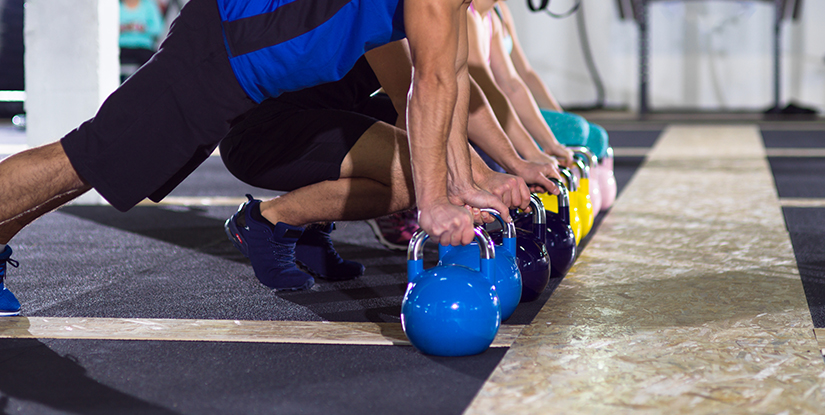The kettlebell long cycle workout is a highly effective and dynamic training method that involves continuous repetitions of the clean and jerk movement. This workout is widely popular in Girevoy Sport (GS), a competitive kettlebell lifting discipline, as well as in functional fitness programs. The kettlebell long cycle workout is renowned for its ability to develop strength, endurance, and power through sustained, rhythmic movements that challenge both muscular and cardiovascular systems. Athletes and fitness enthusiasts incorporate this routine to improve explosive power, grip strength, and overall conditioning. By maintaining a steady pace and focusing on proper breathing techniques, individuals can enhance work capacity, mental resilience, and aerobic efficiency, making it an excellent choice for those looking to build functional strength and stamina.
What is a Kettlebell Long Cycle Workout?
The kettlebell long cycle workout is a high-intensity, full-body exercise that consists of two primary movements: the clean and the jerk. It is a core component of Girevoy Sport (GS) and is also widely used in functional fitness programs to improve strength, endurance, and cardiovascular capacity. The exercise involves cleaning the kettlebell from the ground or a low-hanging position to the rack position at chest level, followed by a jerk, which explosively drives the kettlebell overhead using leg and arm power. The movement is repeated for an extended duration, making it a demanding but highly effective conditioning exercise.
Unlike the short cycle, which consists only of jerks without the clean, the kettlebell long cycle workout engages more muscle groups, making it a superior choice for improving overall fitness. This routine challenges the legs, core, shoulders, and grip strength, while also promoting aerobic endurance and mental toughness. Due to the continuous nature of the movement, it requires efficient breathing, proper technique, and strategic pacing to sustain performance over time.
Kettlebell Long Cycle Program: Structured Training for Maximum Results
A well-designed kettlebell long cycle program follows a progressive structure to enhance endurance, power, and technical proficiency. This type of training typically includes:
- Warm-ups to activate key muscle groups and improve mobility.
- Drills focused on refining the clean and jerk technique.
- Timed sets to build endurance and work capacity.
- Strength training to support explosive power and stability.
- Recovery strategies to prevent fatigue and optimize performance.
By following a structured kettlebell long cycle program, lifters can develop greater work efficiency, enhanced muscular endurance, and improved overall conditioning, making it a powerful addition to any fitness routine.
Muscles Worked in a Kettlebell Long Cycle Workout
The kettlebell long cycle workout is a compound, full-body exercise that targets multiple muscle groups simultaneously. By combining dynamic movements like the clean and jerk, this workout offers an unparalleled strength and conditioning challenge.
Legs
- Glutes
The clean and jerk require powerful hip extension, which heavily engages the glute muscles for driving the kettlebell upward. Additionally, squatting to bring the kettlebell into position engages the glutes for stabilization.
- Hamstrings
The hamstrings are activated during the clean portion, particularly when lifting the kettlebell from the ground and through the hinge motion of the hips. They also contribute to maintaining proper posture throughout the movement.
- Quads
As you squat to perform the clean and stabilize during the jerk, your quads work to support the movement, especially in the leg drive when pushing the kettlebell overhead.
Back
- Latissimus Dorsi: The clean requires a strong pull from the lats, which help control the kettlebell’s ascent and bring it into the rack position. The lats also assist in stabilizing the overhead jerk position.
- Traps: The traps engage during the clean to help control the kettlebell and to ensure proper stability in the rack position. The traps also contribute to the stabilization needed when jerking the kettlebell overhead.
- Lower Back: The lower back, especially the erector spinae, plays a crucial role in stabilizing the spine during both the clean and the jerk. It helps maintain a neutral back position and prevent injury, particularly when transitioning from the squat to the jerk.
Arms and Shoulders
- Biceps: The biceps are engaged during the clean to help guide the kettlebell into the rack position. They assist in the lifting motion and help stabilize the kettlebell during the upward pull.
- Triceps: The triceps are fully activated during the jerk, helping to lock out the kettlebell overhead and maintain stability. They assist in the pressing motion to stabilize the weight in the locked-out position.
- Deltoids: The deltoids are heavily involved in both the clean and jerk. During the clean, they help control the kettlebell as it swings up to the rack position, while during the jerk, they stabilize the kettlebell overhead.
Core
- Abs and Obliques: The core is continuously engaged throughout the kettlebell long cycle workout. During the clean, your core helps to maintain posture and stability as you bring the kettlebell into position. In the jerk, your abs and obliques stabilize the torso, keeping you from overextending or collapsing during the overhead push.
- Overall Core Stability: A key component of the long cycle is its focus on core stability. The continuous movement and need for balance throughout both phases of the exercise challenge your core muscles, promoting improved strength and endurance in the trunk.
The kettlebell long cycle workout is a powerful compound exercise that targets multiple muscle groups—legs, back, arms, shoulders, and core—at once. This full-body effort boosts strength, endurance, and cardiovascular fitness while enhancing calorie burn, muscle growth, and functional strength. By training several areas together, it promotes balanced development, better coordination, and greater overall athletic performance.
Benefits of the Kettlebell Long Cycle Workout
The kettlebell long cycle workout offers a wide range of benefits for individuals looking to improve their overall fitness. This workout involves dynamic, full-body movements that engage multiple muscle groups simultaneously, leading to significant strength, conditioning, and cardiovascular improvements. Below are six key benefits of incorporating the kettlebell long cycle workout into your training routine:
Strength Building
The kettlebell long cycle workout is highly effective for building overall body strength. By combining the clean and jerk movements, you engage multiple muscle groups in a compound manner. The explosive nature of the movements builds strength in the legs, back, arms, and core, leading to better overall strength development. This workout is particularly beneficial for athletes and individuals seeking to enhance their strength in a time-efficient way.
Cardiovascular Conditioning
One of the standout benefits of the kettlebell long cycle workout is its ability to improve cardiovascular conditioning. The sustained effort required to perform the long cycles elevates the heart rate, improving endurance and cardiovascular health. Over time, incorporating this workout into a long cycle kettlebell program will help enhance aerobic capacity, enabling you to perform better in other physical activities and sports.
Power Development
The explosive jerking motion involved in the kettlebell long cycle workout is excellent for developing power. The jerk movement, in particular, requires quick and forceful muscle contractions that enhance explosive strength. Regular practice of the kettlebell long cycle workout will improve your ability to generate force rapidly, making it an ideal training method for athletes looking to boost their power in activities like sprinting, jumping, or lifting.
Functional Fitness
A key benefit of the kettlebell long cycle workout is its ability to improve functional fitness. Functional movements, like the clean and jerk, mimic real-life activities such as lifting, carrying, and overhead pressing. This workout also boosts grip strength, core stability, and coordination, all of which contribute to better performance in daily activities and sports. By integrating the long cycle kettlebell program into your routine, you enhance your body’s ability to move efficiently and safely during various tasks.
Fat Burning
Due to its high-intensity nature, the kettlebell long cycle workout is a fantastic choice for fat burning. The combination of strength training and cardiovascular effort increases calorie burn during the workout and accelerates post-exercise fat loss. This makes it an effective tool for those looking to shed excess body fat while simultaneously building lean muscle. The long cycle kettlebell program is an ideal way to target fat loss while developing muscle endurance and strength.
Time-Efficient Workout
One of the primary advantages of the kettlebell long cycle workout is its ability to deliver maximum results in a short amount of time. Because the workout engages multiple muscle groups and boosts both strength and cardiovascular fitness simultaneously, it allows you to get a full-body workout in a shorter period compared to traditional gym routines. This time-efficient workout is perfect for individuals with a busy schedule who still want to achieve their fitness goals.
Incorporating the kettlebell long cycle workout into a long cycle kettlebell program provides a well-rounded fitness plan that improves strength, cardiovascular health, power, and fat loss, all while boosting functional fitness and efficiency.
How to Perform the Kettlebell Long Cycle Workout
The kettlebell long cycle workout is a highly effective training method that involves two main movements: the clean and the jerk. By mastering these steps, you can build full-body strength, power, and endurance. Below is a detailed guide on how to properly perform the kettlebell long cycle workout, with an emphasis on correct form and technique.

Clean the Kettlebell to the Rack Position
To begin, place the kettlebell on the floor in front of you. Stand with your feet shoulder-width apart and bend at the hips to grab the kettlebell with one hand. Perform a hip hinge by driving your hips back, not squatting down. Explosively extend your hips and knees to bring the kettlebell up, swinging it towards your body. As the kettlebell reaches chest height, rotate your wrist and “catch” the kettlebell in the rack position — with the kettlebell resting against your forearm, the handle close to your chest, and your elbow tucked at your side. Your grip should be firm, but not tight, and your wrist should be neutral. This is a key aspect of kettlebell long cycle training as it sets up the next movement.
Jerk the Kettlebell Overhead Using Leg Drive
Once the kettlebell is in the rack position, bend your knees slightly and lower your body to prepare for the jerk. Use the power from your legs to explode upward while pressing the kettlebell overhead. Focus on driving through your heels and using your hips to generate momentum. At the top of the movement, ensure that your arm is fully extended, with the kettlebell directly overhead and your elbow locked out. Your core should be engaged to maintain stability throughout this phase. Proper leg drive is essential for efficiently lifting the kettlebell and completing the kettlebell long cycle workout with the correct technique.
Return the Kettlebell to the Rack Position
After you’ve completed the jerk, it’s time to bring the kettlebell back to the rack position. To do this, lower the kettlebell by gently bending your arm and guiding it down to your chest while keeping the elbow close to your body. Ensure that your back stays straight and that you control the kettlebell on the way down. Avoid any jerky movements to maintain control and reduce the risk of injury. This step ensures the kettlebell is ready for the next cycle of the kettlebell long cycle workout.
Lower the Kettlebell Back to the Starting Position
To finish the cycle, lower the kettlebell back to the starting position, which is near your feet. To do this, hinge your hips again and lower the kettlebell while maintaining a neutral spine. The kettlebell should swing slightly forward before reaching the floor. Avoid rounding your back, as this can lead to strain and injury. The motion should be controlled and deliberate to complete the full cycle and prepare for the next repetition.
Detailed Form and Technique Instructions
Proper form is essential to executing the kettlebell long cycle workout safely and effectively. Here are some important tips to keep in mind:
- Rack Position
The kettlebell should rest comfortably against your forearm with your elbow tucked in. Avoid letting your arm hang loosely, as this can lead to a lack of control and a less efficient workout.
- Leg Drive
When performing the jerk, use your legs to generate the power, not just your arms. A strong leg drive helps you lift the kettlebell more efficiently and reduces strain on your shoulders.
- Core Engagement
Throughout the entire movement, keep your core engaged. This stabilizes your body and protects your lower back during both the clean and jerk phases of the kettlebell long cycle workout.
- Breathing
Be mindful of your breathing during the workout. Inhale during the clean and exhale during the jerk. Breathing properly helps you maintain energy levels and stability throughout the movement.
Common Mistakes to Avoid
- Poor Rack Position
One common mistake is letting the kettlebell rest too far from your body in the rack position. This reduces control and efficiency. Always keep the kettlebell close to your torso.
- Insufficient Leg Drive
Failing to engage your legs fully during the jerk can cause you to rely on your arms, which is less efficient and may lead to fatigue more quickly. Make sure to focus on using your legs to generate power.
- Lack of Lockout
When pressing the kettlebell overhead, ensure that your elbow is fully locked out. A partial lockout reduces the effectiveness of the exercise and increases the risk of injury.
Stick to the right steps and stay focused on good form, and you’ll be able to crush the kettlebell long cycle workout and reap its full rewards.
Related Articles
Kettlebell Pentathlon: Guide for Beginners and Beyond
Clean: How I Fixed My Form & Saved My Wrist
Kettlebell Clean and Press: How to Master
Jerk: How I Fixed Pain, Pressure & My Form
Kettlebell Half Snatch: Form, Fixes, and Key Benefits
Kettlebell Push Press: Form Tips, Muscles Worked & Benefits
FAQs about Kettlebell Long Cycle Workout
The kettlebell long cycle is a two-phase movement combining the clean and the jerk. You clean the kettlebell(s) from the ground to your chest (the rack position), then perform a jerk to press them overhead. It’s a full-body endurance and strength test that targets your legs, core, shoulders, and grip. Typically done with one or two kettlebells, it’s used in both sport and general conditioning. The long cycle challenges not only muscular strength but also cardio, breathing technique, and pacing. Because of its intensity, it builds power and stamina fast—especially when performed for time or high reps.
Kettlebell long cycle standards vary slightly between organizations but generally follow core rules. First, each rep must begin with a clean to the rack position, followed by a full overhead lockout in the jerk phase. You must pause in the rack between each rep—no bouncing straight into the next jerk. Proper form requires knees, hips, and elbows to fully lock out overhead. In competitions, reps are judged based on precision, posture, and consistency, often within a 10-minute time cap. Lifters are also expected to keep both hands on the kettlebells unless switching sides (in one-arm events).
Doing 200 kettlebell swings a day can rapidly build cardiovascular endurance, grip strength, and posterior chain power—especially in your glutes, hamstrings, and lower back. Over time, you’ll likely notice improved conditioning and fat loss, provided your form stays clean and your recovery is dialed in. However, going too hard too often without rest or variation can lead to overuse injuries. It’s effective if programmed intelligently, but you should watch for signs of fatigue or poor form creeping in. Add mobility work and avoid neglecting other movement patterns to stay balanced and injury-free.
As of now, the world record for the kettlebell long cycle depends on the weight class, bell size, and federation. In professional kettlebell sport, elite lifters often complete over 100 reps in 10 minutes using two 32kg kettlebells—that’s over 7,000 kg lifted in one set. One notable record includes Ivan Denisov completing 87 reps with double 32kg kettlebells in 10 minutes under international standards. These feats require years of training, refined technique, and elite conditioning. Records may vary slightly across Girevoy Sport federations like IKSFA, IUKL, and WAKSC, but all are incredibly demanding.

Hi, I’m the editor here at Leadman Fitness. We’re a manufacturer focused on producing top-quality barbells, plates, kettlebells, dumbbells, and strength training gear. I’ve been into sports and fitness for years, and I know my way around all kinds of gym equipment—both from using it and helping create it.
I spend a lot of time understanding the real problems people run into in the gym—whether it’s beginners trying to pick the right gear or experienced lifters looking for something more durable. I stay in close touch with our production team and talk directly with other equipment makers, so we’re always improving based on what real lifters and coaches are looking for.
What I share comes from hands-on experience—stuff that actually helps people train better, not just in theory, but in real gyms.
